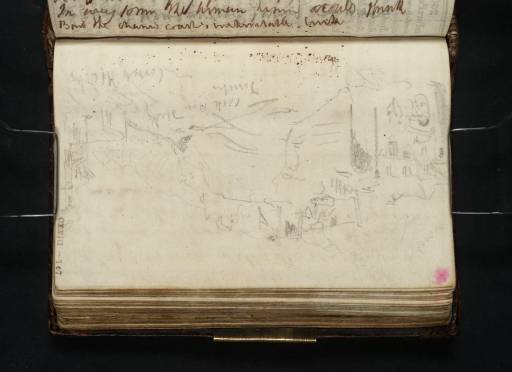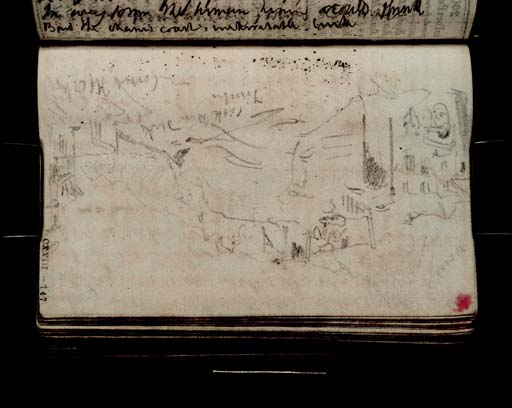Joseph Mallord William Turner A Lime Kiln at Combe Martin 1811
Image 1 of 2
Joseph Mallord William Turner,
A Lime Kiln at Combe Martin
1811
Joseph Mallord William Turner 1775–1851
Folio 150 Recto:
A Lime Kiln at Combe Martin 1811
D08646
Turner Bequest CXXIII 147
Turner Bequest CXXIII 147
Pencil on white wove writing paper, 75 x 117 mm;
Part watermark ‘Sm | 17’
Inscribed by Turner in pencil ‘wood’ top left, ‘Pack [?Hrs Donky] | Timber’ below centre, and ‘Comb Martin’ bottom right
Inscribed by John Ruskin in red ink ‘147’ top left, ascending vertically
Stamped in black ‘CXXIII – 147’ top right, ascending vertically
Part watermark ‘Sm | 17’
Inscribed by Turner in pencil ‘wood’ top left, ‘Pack [?Hrs Donky] | Timber’ below centre, and ‘Comb Martin’ bottom right
Inscribed by John Ruskin in red ink ‘147’ top left, ascending vertically
Stamped in black ‘CXXIII – 147’ top right, ascending vertically
Accepted by the nation as part of the Turner Bequest 1856
References
1909
A.J. Finberg, A Complete Inventory of the Drawings of the Turner Bequest, London 1909, vol.I, p.350, CXXIII 147, as ‘“Combe Martin”’.
1968
Luke Herrmann, Ruskin and Turner: A Study of Ruskin as a Collector of Turner, Based on his Gifts to the University of Oxford; Incorporating a Catalogue Raisonné of the Turner Drawings in the Ashmolean Museum, London 1968, p.67 under no.24.
1979
Andrew Wilton, J.M.W. Turner: His Life and Work, Fribourg 1979, p.354 under no.476.
1981
Eric Shanes, Turner’s Rivers, Harbours and Coasts, London 1981, p.152.
2000
Luke Herrmann and Colin Harrison, J.M.W. Turner, Ashmolean Handbooks, Oxford 2000, p.[56] under no.23.
The view, dominated by a lime kiln in the foreground, is to the north-west across Combe Martin’s small harbour off Cross Street. Beyond, houses rise on what is now called Seaside Hill and coastal cliffs recede towards Burrow Nose in the distance on the right. The site is known as Kiln Car Park; there were once eighteen kilns around the village.1 There is an early photograph showing the kiln above the harbour from the north-west (Combe Martin Museum).2
Luke Herrmann and others have noted this sketch as the basis of the watercolour Combe Martin, Devonshire of about 1824 (Ashmolean Museum, Oxford),3 engraved in 1825 for the Picturesque Views on the Southern Coast of England4 (see the concordance of the series in the 1811 tour introduction). Horses or mules with panniers and a donkey are shown in the position corresponding with Turner’s inscription here.
See ‘Trade and Settlement North Devon Walk: Combe Martin’, North Devon Coast Areas of Outstanding Natural Beauty, accesded 18 March 2011, http://www.northdevon-aonb.org.uk/pdf/trails_combe_martin.pdf .
‘Pictures of Combe Martin’, Explore North Devon, accessed 18 March 2011, http://www.explorenorthdevon.org/clcnressduida.aspx?cid=31&cname=Combe%20Martin%20Museum&ccde=cmma&clcnid=300&clcnt=Pictures%20of%20Combe%20Martin&cwhat=False&cwhen=False&cwhere=False&cwho=False&clcnr=3&txts=3882 .
Technical notes:
There is some offsetting from the ink inscription on folio 149 verso opposite (D08645; CXXIII 146a).
Verso:
Blank
Matthew Imms
June 2011
How to cite
Matthew Imms, ‘A Lime Kiln at Combe Martin 1811 by Joseph Mallord William Turner’, catalogue entry, June 2011, in David Blayney Brown (ed.), J.M.W. Turner: Sketchbooks, Drawings and Watercolours, Tate Research Publication, December 2012, https://www


